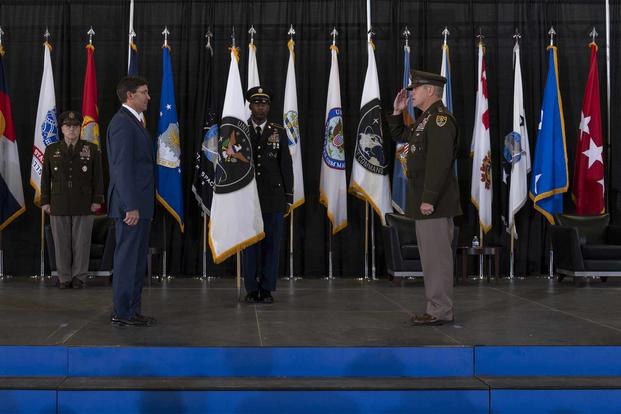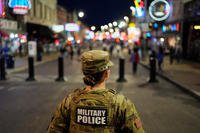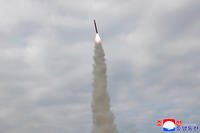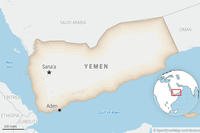The Army now has more four-star generals serving on active duty than the Army and Air Force combined had during World War II.
Army Col. Christopher Coglianese, the chief of Future Operations at Army Futures Command, tweeted this month about the milestone, which the service has only hit once in the past.
"Last time we had that rank density was April 1945, when we had four five-stars and 13 four-stars," Coglianese said, adding pointing out that at that time the Air Force was known as the U.S. Army Air Force.
Read Next: Space Force Now Has an Official Uniform
In addition to Army Chief of Staff Gen. James McConville and Army Vice Chief of Staff Gen. Joseph Martin, the Army has five four-stars running Army Forces Command, Army Training and Doctrine Command, Army Materiel Command, Army Futures Command and Army Pacific Command.
Currently, the Army also holds 10 four-star positions in the joint world starting with Gen. Mark Milley, chairman of the Joint Chiefs of Staff.
Three of those are newly confirmed joint positions. As of June, 30, there were 14 Army four-stars, according to Defense Department figures. But Gen. Gus Perna, who was the commander of Army Materiel Command (AMC), was confirmed by the Senate on July 2 as commander of Operation Warp Speed, the sweeping effort to accelerate the development, manufacturing, and distribution of COVID-19 vaccines, therapeutics, and diagnostics.
Gen. Edward Daly took over the four-star slot at AMC.
The second new Army four-star to take over a joint position since June 30 was Gen. Daniel Hokanson, who was confirmed by the Senate on July 21 to command the National Guard Bureau. And Army Gen. James Dickinson was confirmed by the Senate on Aug. 6 to lead U.S. Space Command.
"It is true that the Army is at a high point; part of that is that the number of four-stars has been rising slowly over the last two decades," said Mark Cancian, a retired Marine Corps colonel and a senior adviser for the international security program at the Center for Strategic and International Studies.
One of those new Army four-star positions was added when Gen. Mike Murray was confirmed by the Senate on Aug. 20, 2018 to command the new Army Futures Command.
The Army has pulled ahead of the Air Force, "which seems to be the Army's main competitor," Cancian said.
"The Navy is perennially in third place, and periodically the Marine Corps surges up," Cancian said.
One reason for the Army's current dominance in the joint world is that the most recent conflicts had a heavy Army presence.
"We have been at war for two decades in Iraq and Afghanistan; those have been ground conflicts, so Army officers get more visibility and experience," Cancian said. "It's always a good sign when a service has a lot of four-stars because that means it is putting forward a level of talent and experience."
The trend is not likely to last too long, though, Cancian said.
"These things have cycles and the Army is at an upcycle now," Cancian said. "But I wouldn't be surprised if five years from now the Air Force and the Navy have a little uptick with the continuing focus on China."
Matthew Cox can be reached at matthew.cox@military.com.
Related: Major Power Shift Underway at Pentagon as Army Leaders Step Up














